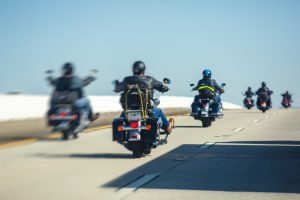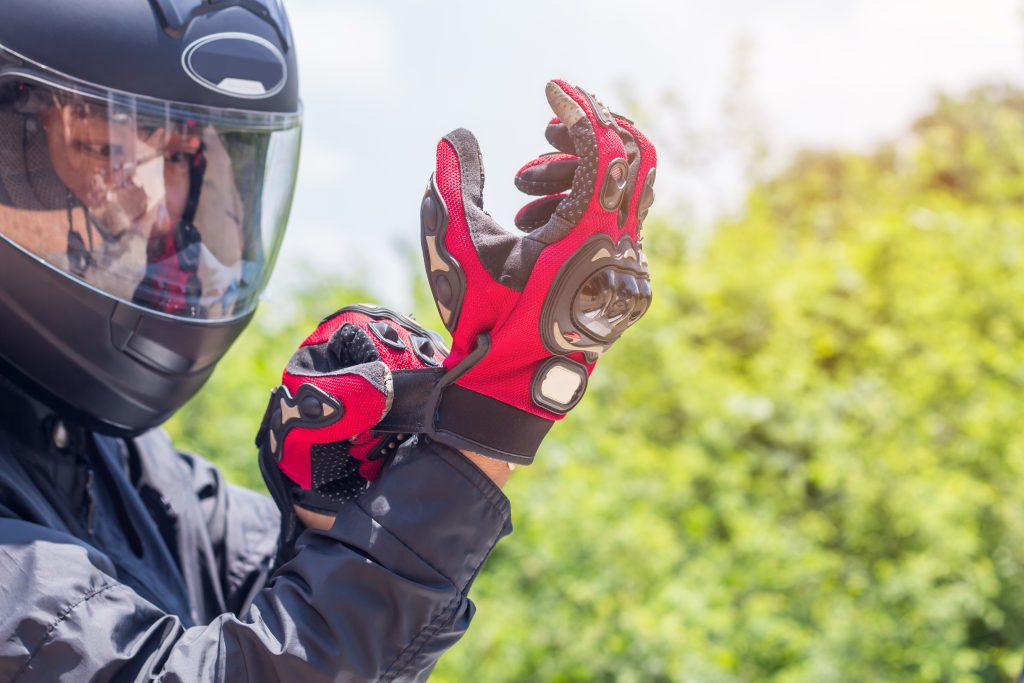
Motorcycle operators are subject to all the same basic rules of the road as other drivers. Motorcyclists must follow all traffic signals, obey the speed limit, and adhere to the rules that define right-of-way. Motorcycles pose some additional safety challenges, however, so there are several extra laws in place to protect riders. Here, we’ll cover the current Maryland motorcycle laws related to required licensing, safety equipment and rules of the road.
Required Licensing
To drive a motorcycle in Maryland, drivers need a Class M license. For inexperienced riders, or those new to motorcycles, the MVA Motorcycle Operator Manual is a great place to start reading and studying. See the MDOT MVA site for more information on the process of obtaining a Class M license.
 Required Safety Equipment
Required Safety Equipment
Helmet
In Maryland, motorcyclists must wear a U.S. Department of Transportation (DOT) compliant motorcycle helmet.
Motorcycle helmets sold in the United States are required to meet the minimum safety requirements. If in doubt, check for the DOT sticker to make sure it’s certified for motorcyclists and not intended for some other purpose.
Eye Protection
Maryland law also requires riders to use windscreens or other approved eye-protection — such as goggles or a face-shield. Again, these should meet FDA safety standards, indicating they are impact resistant. They should also be non-tinted if conditions are such that drivers are required to use headlights (night driving, tunnels, etc.).
Current Maryland Motorcycle Laws
You must obey all applicable Maryland traffic laws.
All traffic laws that apply to other vehicles also apply to motorcycles. These include obeying all traffic signals, yielding when other vehicles have the right of way and driving within the posted speed limit.
You may operate a motorcycle only from the permanent, attached seat.
This is the only position that allows safe steering, stopping, and controlling a motorcycle.
Passengers may only ride on motorcycles designed to accommodate them.
Safety engineers consider the weight and positioning of passengers in motorcycle design. Sitting elsewhere could result in loss of control of the bike and a potentially deadly crash. Passengers must not ride in such a way that they interfere with the driver’s ability to see the road or control the motorcycle.
Riders must keep both hands on the handlebars.
This is about maintaining control of the bike and safety of the rider. You’re not permitted to hold a package under one arm, a drink in your hand or anything that would take your hands off the handlebars. If you need to carry something while riding, it must be secured to your bike.
Motorcycles get full use of the width of the lane they’re riding in.
Although they don’t take up the entire space, motorcyclists are entitled to the full width of their lane. Other vehicles should treat motorcycles as though they are a full-sized vehicle, never crowding them or trying to pass them by invading their lane.
Two motorcycles may share a single lane.
This is the one exception to the previous situation. Two motorcycles may ride side by side, sharing a lane. Two is the limit, however. It’s never safe for three or more motorcycles to ride abreast in a single lane.
Motorcyclists may not ride between lanes.
This practice, also known as lane-splitting, is illegal in Maryland. A motorcycle may not travel in between designated lanes, regardless of whether the traffic is moving or stopped.
Motorcyclists must use the adjacent lanes while passing other vehicles.
This is related to lane-splitting. You can’t enter another vehicle’s lane while passing, even if it appears that there is enough space to do so.
Some roadways require a minimum engine size for motorcycle use.
If your motorcycle has a motor with a rating of 1.5 brake horsepower or less, or a capacity of less than 70 cubic centimeters piston displacement, you cannot ride on expressways, controlled access highways or any road where the maximum speed limit is 50 mph or higher.
You cannot cling to other vehicles while riding a motorcycle.
This should go without saying, but it is illegal (not to mention extraordinarily dangerous) to hold on to another moving vehicle while riding or operating a motorcycle. If you need to transport your bike, use a proper trailer.
Ride Safely and Arrive Safely Home
Motorcyclists cannot control other drivers on the roadway, but you can and should make yourself as safe as possible before heading out for your ride.